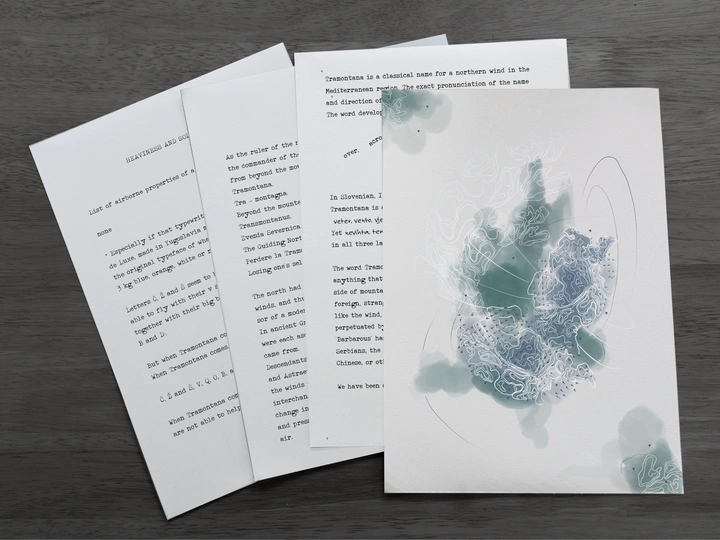Tracing Tramontana: being with(-in) the wind

midve is composed of Eva Tisnikar and Carlota Nunez-Barranco Vallejo who have been working, thinking, or daydreaming together since 2017 when they met in London.
Originally from a small coastal town in Slovenia, Eva is currently working as an Architectural Researcher at a global practice while also teaching at various universities. After finishing her BSc in Architectural & Interdisciplinary Studies, where she explored sound and new media art alongside more traditional architectural tools for communication, Eva started to explore film and writing. During her degree in Architectural History, Theory & Criticism, focusing on ecology and gender in the urban context, she directed an award-winning short film Counterproductive (2021) that was showcased on international film festivals. Her research into urban soundscapes and the role of sound in experiences of belonging and processes of othering has been recently published in Sage’s Urban Studies journal.
Born at the outskirts of Madrid, Carlota is an architect currently working as a 3D Artist & Visualiser at Jason Bruges Studio in London. She designs and visualises interactive, data-driven, site-specific artworks in the urban environment. Having graduated from an architectural film unit, Carlota explores the relationship between time and space, and the way people navigate it, with a passion for storytelling. She is particularly interested in different narrative techniques that centre around characters. Her research explored the emancipation of women in Spain through an intergenerational analysis of cooking. She has experimented with a variety of methods, such as site-specific mapping of film characters to deduce camera movements, and designing a story projected onto a physical set moved by a robotic arm. Carlota’s recent work includes directing and animating an introductory film for a new programme, published multimedia drawings and film editing for an award-winning film Counterproductive (2021) amongst others.
Tracing Tramontana is an ecopoetic experiment in windy site-writing that intertwines science with history, feminist geography, and ecology. Tramontana is a strong, hurricane-like wind that blows from the Alps over Trieste Bay to the Slovenian coast and Istria. Characterised by its transient and turbulent nature, the wind crosses the national borders of Italy, Slovenia, and Croatia, as it unravels over the Adriatic Sea. Despite its potent effect on the local landscape and architecture, the wind remains invisible on global meteorological animations. This discrepancy between scientific tools and the wind’s embodied brute force represents the problematic modern dichotomy of man versus nature.
The project aims to reattune to the wind, the weather, the climatic and the body, by developing a posthuman subjectivity, adapted from Neimanis (2016), that is fluid and embodied. Exploring what this wind does - where it comes from, where it goes, and what it means along the way – the project suggests writing, drawing and thinking with-in the wind is a productive space for new affirmative relations that are creative and critical. Engaging with languages, landscapes, the senses, and other biological processes like breathing, we seek to connect human bodies with other bodies of ‘other waters’ and other airs.
To think within the wind rejects human separation from nature and alters our ‘accepted cartographies’ of space, time, and species, so that ‘matter can matter differently’ (Neimanis 2016:4-5). In this case, tracing Tramontana developed into a creative practice that involved drawing meteorological pressure diagrams, digitally painting the shapes of clouds with the colours of the sea when the wind is approaching. Using digital media in order to trace the wind subverts the role of technology, which is commonly distancing us from the weather phenomena. Future explorations will involve extensive weather data, use of animation, writing and sound recording, resulting in a performance.